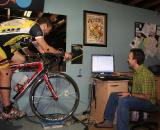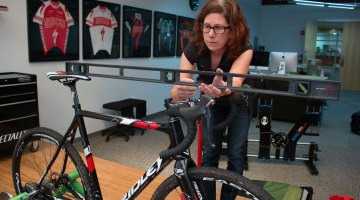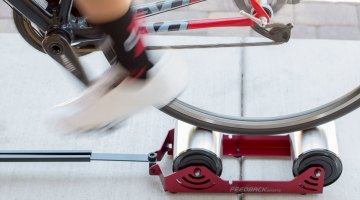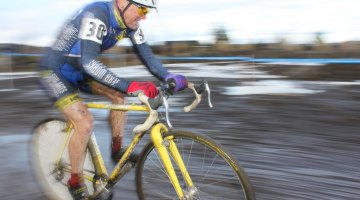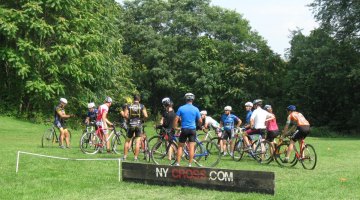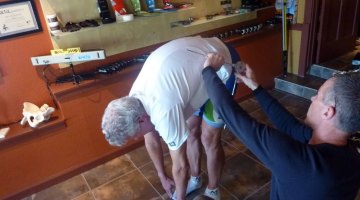Does your back hurt during ’cross? Setting up a new ’cross bike and wondering if your setup is really dialed? Spring and summer is the time to figure these issues out. We’re here to help.
When it comes to cyclocross, the bike fit conundrum comes with a host of oft-repeated truths. These include buying a smaller frame, lowering your saddle, moving the saddle forward, moving it back, and raising your bars. Do these ‘truths’ hold water?
In the upcoming Issue 17, we look at cyclocross bike fit, but to get you thinking about your fit, Cyclocross Magazine contributor Bill Schieken recently talked with Beth Mason about bike fit issues specific to cyclocrossand what you can do to be more comfortable and efficient during the upcoming season. Mason is a licensed physical therapist, certified bike fitter, and Cat 1 road and cyclocross racer (www.bethbikes.com). This triple threat of experience provides Beth with a rock solid perspective on common fit issues facing anyone toeing the line at a cyclocross event. Here are some highlights from Schieken’s conversation with Mason.
You are a successful cyclocross racer and you also run a bike fitting business. What I am hoping is that you can clear up some oft-repeated “truths” about getting fit to a cyclocross bike. I know that fit is unique to every rider, but what are some general things you may do differently when fitting somebody to a cyclocross bike as opposed to a road bike?
MASON: Truthfully, nothing. If the fit were completely up to me, everyone would have the exact same fit that they have on their road bike (provided the fit is ideal). You hit the nail on the head, however, when you said that the fit is unique to every rider. The fit is never up to me, and nor should it be. Fitting a bike is a client driven business, and a bike fit needs to factor in each client’s biomechanics, injury history, and personal preferences. Some people swear they need wider bars on the ’cross bike than they do on their road bike. I actually run wider bars on my cyclocross bike, and I like them. Some people talk about a lower and further aft saddle on the ‘cross bike. This can be useful for some people to increase the ease of the remount. I think this saddle position is appropriate for technical mountain biking, when more time is spent hovering over your saddle than sitting on it. In cyclocross, however, you should be spending more time sitting on your saddle.
How about position on the bike? Do you need to be more upright on a ’cross bike then on a road rig?
MASON: It isn’t as important to be low in cyclocross with the slower speeds and less impact from the wind. Therefore, more upright might mean more comfort. I typically aim for the same back angle on a cyclocross bike as I do on a road bike, which is usually 40-45 degrees. In the end, my goal is to find the right position that will maximize rider comfort and pedaling economy.
I know when I first started racing ‘cross, my lower back would be killing me by the end of a race. This is a complaint I hear from a lot of people just starting to race. For me, really concentrating on strengthening my core took care of most of the pain. Is that going to be the case for most newbies? Or are there some common bike set-up mistakes that may contribute to the pain?
MASON: I love back pain! Back pain is what I am all about. I would like to do a poll of cyclocross racers and back pain to see how many of us have suffered with this during the season. It is tough to make a blanket statement about what might cause low back pain in cyclocross newbies … but let me take a stab at it:
- Poor technique in the remount — The “Superman” will take its toll on your lower back. Believe me.
- Bouncing around — Those of us who primarily ride pavement are not accustomed to the jarring of the bike over a range of terrain. Invest in a set of tubies and drop the tire pressure. This helps out a LOT.
- Your saddle further back — You will be pulling a lot more with your hamstrings in this position. The hamstrings attach to your pelvis which attaches to your sacrum (tailbone) and then to your lower back, causing a lot of extra work in this area and making it go “ow.”
- Running — Again, something a lot of us aren’t used to doing, and the jarring effect can cause back pain.
- Mud — Slogging through the thick stuff and lugging your heavy bike through it as well will cause your back to ache.
Also, core strengthening is much more important to the cyclocross racer than to the road racer. If I could recommend two exercises to concentrate on, it would be the plank and the side plank.
You use the Retül fitting system. It looks pretty high-tech. Give us a run down of the fitting process.
MASON: The Retül is a tool, and not a fitting system. By gathering data from eight key anatomical points in the cyclist’s riding position, fitters are able to profile existing (before) and ideal (after) angles for their client’s custom needs, i.e. gaining efficiency, performance, comfort, or accommodating injuries.
Stay tuned for more bike fit discussion in Issue 17 of Cyclocross Magazine.













